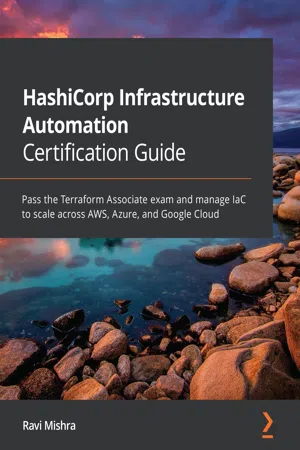
HashiCorp Infrastructure Automation Certification Guide
Pass the Terraform Associate exam and manage IaC to scale across AWS, Azure, and Google Cloud
- 350 pages
- English
- ePUB (mobile friendly)
- Available on iOS & Android
HashiCorp Infrastructure Automation Certification Guide
Pass the Terraform Associate exam and manage IaC to scale across AWS, Azure, and Google Cloud
About This Book
Leverage Terraform's capabilities to reuse code, write modules, automate deployments, and manage infrastructure state
Key Features
- Perform complex enterprise-grade infrastructure deployments using Terraform v1.0, the latest version of Terraform
- Learn to scale your infrastructure without introducing added deployment complexities
- Understand how to overcome infrastructure deployment challenges
Book Description
Terraform is a highly sought-after technology for orchestrating infrastructure provisioning. This book is a complete reference guide to enhancing your infrastructure automation skills, offering up-to-date coverage of the HashiCorp infrastructure automation certification exam. This book is written in a clear and practical way with self-assessment questions and mock exams that will help you from a HashiCorp infrastructure automation certification exam perspective. This book covers end-to-end activities with Terraform, such as installation, writing its configuration file, Terraform modules, backend configurations, data sources, and infrastructure provisioning. You'll also get to grips with complex enterprise infrastructures and discover how to create thousands of resources with a single click. As you advance, you'll get a clear understanding of maintaining infrastructure as code (IaC) in Repo/GitHub, along with learning how to create, modify, and remove infrastructure resources as and when needed. Finally, you'll learn about Terraform Cloud and Enterprise and their enhanced features.
By the end of this book, you'll have a handy, up-to-date desktop reference guide along with everything you need to pass the HashiCorp Certified: Terraform Associate exam with confidence.
What you will learn
- Effectively maintain the life cycle of your infrastructure using Terraform 1.0
- Reuse Terraform code to provision any cloud infrastructure
- Write Terraform modules on multiple cloud providers
- Use Terraform workflows with the Azure DevOps pipeline
- Write Terraform configuration files for AWS, Azure, and Google Cloud
- Discover ways to securely store Terraform state files
- Understand Policy as Code using Terraform Sentinel
- Gain an overview of Terraform Cloud and Terraform Enterprise
Who this book is for
This book is for experienced cloud engineers, DevOps engineers, system administrators, and solution architects interested in developing industry-grade skills with Terraform. You will also find this book useful if you want to pass the HashiCorp Certified: Terraform Associate exam. Basic command-line skills and prior knowledge of cloud environments and their services are required before getting started with this book.
Frequently asked questions
Information
Section 1: The Basics
- Chapter 1, Getting to Know IaC
- Chapter 2, Terraform Installation Guide
Chapter 1: Getting to Know IaC
- Introduction to IaC
- Advantages of IaC
- Introduction to Terraform
- A comparison with other IaC
- An understanding of Terraform architecture
Technical requirements
Introduction to IaC
Advantages of IaC
Simple and speedy
Configuration consistency
Risk minimization
Table of contents
- HashiCorp Infrastructure Automation Certification Guide
- Contributors
- Preface
- Section 1: The Basics
- Chapter 1: Getting to Know IaC
- Chapter 2: Terraform Installation Guide
- Section 2: Core Concepts
- Chapter 3: Getting Started with Terraform
- Chapter 4: Deep Dive into Terraform
- Chapter 5: Terraform CLI
- Chapter 6: Terraform Workflows
- Chapter 7: Terraform Modules
- Section 3: Managing Infrastructure with Terraform
- Chapter 8: Terraform Configuration Files
- Chapter 9: Understanding Terraform Stacks
- Chapter 10: Terraform Cloud and Terraform Enterprise
- Chapter 11: Terraform Glossary
- Assessments
- Other Books You May Enjoy